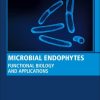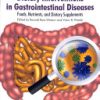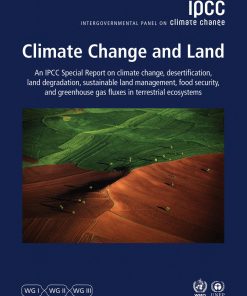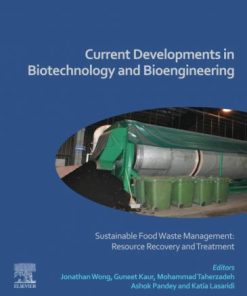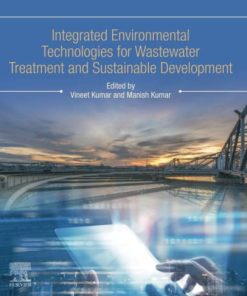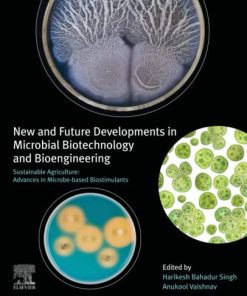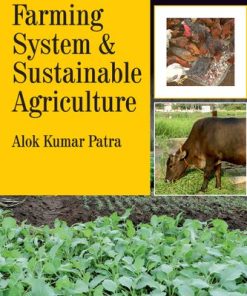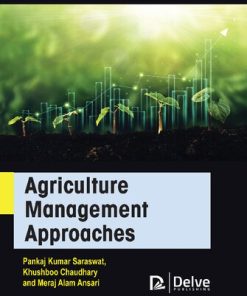PGPR Amelioration in Sustainable Agriculture Food Security and Environmental 1st edition by Management Kumar 0128160190 9780128160190
$50.00 Original price was: $50.00.$25.00Current price is: $25.00.
PGPR Amelioration in Sustainable Agriculture: Food Security and Environmental 1st edition by Management Kumar – Ebook PDF Instant Download/DeliveryISBN: 0128160190, 9780128160190
Full download PGPR Amelioration in Sustainable Agriculture: Food Security and Environmental 1st edition after payment.
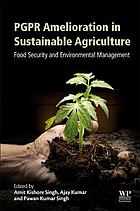
Product details:
ISBN-10 : 0128160190
ISBN-13 : 9780128160190
Author: Management Kumar
PGPR Amelioration in Sustainable Agriculture: Food Security and Environmental Management explores the growth-promoting rhizobacteria (PGPR) that are indigenous to soil and plant rhizosphere. These microorganisms have significant potential as important tools for sustainable agriculture. PGPR enhance the growth of root systems and often control certain plant pathogens. As PGPR amelioration is a fascinating subject, is multidisciplinary in nature, and concerns scientists involved in plant heath and plant protection, this book is an ideal resource that emphasizes the current trends of, and probable future of, PGPR developments. Chapters incorporate both theoretical and practical aspects and may serve as baseline information for future research.
This book will be useful to students, teachers and researchers, both in universities and research institutes, especially working in areas of agricultural microbiology, plant pathology and agronomy.
PGPR Amelioration in Sustainable Agriculture: Food Security and Environmental 1st edition Table of contents:
1. Ecology and Diversity of Plant Growth Promoting Rhizobacteria in Agricultural Landscape
1.1 Introduction
1.2 Microbial Diversity Analysis
1.3 Plant Growth Promoting Rhizobacteria
1.4 Spatio-Temporal Changes and Factor Affecting PGPR Diversity
1.5 Phosphate Solubilization
1.6 Siderophore Production
1.7 Nutrient Exchange
1.8 Microorganisms in Agriculture
1.9 Future Perspective
1.10 Conclusions
References
2. Mechanisms of Plant-Microbe Interactions and its Significance for Sustainable Agriculture
2.1 Introduction
2.2 Cataloguing the Plant-Microbe Interaction
2.2.1 A systemic perspective of plant-microbe interaction: Symbiosis verses pathogenesis
2.2.2 Plant-microbe interaction: Biofertilizer
2.2.3 Plant-microbe interactions: Rhizoremediation
2.2.4 Plant-microbe interactions: Biocontrol agent
2.3 Factors Governing Plant-Microbe Interactions
2.4 Applications of Plant-Microbe Interactions
2.5 Conclusion and Future Perspectives
References
Further Reading
3. Plant Growth Promoting Rhizobacteria: Application in Biofertilizers and Biocontrol of Phytopathog
3.1 Introduction
3.2 Plant Growth Promoting Bacteria as Biofertilizer
3.3 Mechanism of Action
3.3.1 Phosphate solubilization
3.3.2 Siderophore production
3.3.3 Phytohormones production
3.3.4 Ammonia and hydrogen cyanide production
3.3.5 Enzyme production
3.3.6 Nitrogen fixation
3.4 Microbial Inoculation for the Plant Growth Promotion
3.5 Plant Growth Promoting Bacteria as Biocontol
3.6 Conclusion
Acknowledgments
References
Further Reading
4. PGPR Bioelicitors: Induced Systemic Resistance (ISR) and Proteomic Perspective on Biocontrol
4.1 Introduction
4.2 PGPR as BCAs and their Mode of Actions
4.2.1 Antibiotics
4.2.2 Siderophores
4.2.3 Cell wall degrading enzymes
4.2.4 Volatile organic compounds
4.2.5 Induced systemic resistance
4.3 Proteomic Perspective on Biocontrol
4.4 Conclusion and Future Perspective
References
Further Reading
5. Amelioration of Salinity Stress by PGPR: ACC Deaminase and ROS Scavenging Enzymes Activity
5.1 Introduction
5.2 Salinity Stress and ROS
5.3 ROS Scavenging in Plants
5.4 Ethylene in Salinity Stress
5.4.1 Regulation of plant stress ethylene levels
5.5 Plant Growth Promoting Rhizobacteria
5.5.1 ACC deaminase-containing bacteria
5.5.2 PGPR and ROS scavenging in salt stress
5.5.3 ACC deaminase containing rhizobacteria in salt stress
5.6 Future Prospective
Acknowledgments
References
Further Reading
6. Role of Plant Growth Promoting Rhizobacteria in Drought Tolerance: Regulating Growth Hormones and
6.1 Introduction
6.2 Drought Adaptations by Plants-Microbe Combination
6.3 Mechanisms Followed by Plants for Drought Tolerance
6.3.1 Maintenance of relative water content for plant adaptation
6.3.2 Generation of less ROS under drought stress
6.3.3 Modulation of plant growth regulators
6.4 PGPR Mediated Phytohormones in Drought Mitigation
6.4.1 IAA producing microbes for drought mitigation
6.4.2 ACC deaminase-containing PGPR in drought tolerance by lowering ethylene levels
6.4.3 PGPR adjusting phytohormone levels other than IAA and ethylene during drought stress
6.5 Osmolytes: Biomolecules to Endure Drought Stress in Plants
6.6 Diversity of Osmoprotectants Among PGPR
6.6.1 Sugar
6.6.2 Sugar alcohols
6.6.3 Amino acids
6.6.4 Quaternary ammonium compounds
6.7 Conclusion
References
7. Plant Growth Promoting Rhizobacteria (PGPR) for Sustainable Agriculture: Perspectives and Challen
7.1 Introduction
7.2 The rhizosphere: A play ground for PGPR activities
7.3 What are plant growth promoting rhizobacteria
7.4 Occurrence and forms of PGPR
7.5 Role of PGPR for sustainable agriculture
7.5.1 PGPR as biofertilizers
7.5.1.1 Biological nitrogen fixation (BNF)
7.5.1.2 Phosphate solubilization
7.5.1.3 Potassium solubilization
7.5.1.4 Siderophore production (Iron chelation)
7.5.1.5 Zinc solubilization
7.5.2 PGPR as phytostimulators
7.5.3 PGPR as biopesticides
7.5.4 PGPR as bioremidators
7.5.5 PGPR for stress management
7.6 Future perspective and challenges
7.7 Concluding remarks
Acknowledgements
References
Further Reading
8. Recent Development of Patent in Indian Scenario With Special Reference to Microbial Patents
8.1 Introduction
8.2 What Can Be Patented?
8.2.1 Patentable subject matter
8.3 Types of Patents
8.3.1 Types of patent application filing in India
8.3.2 Patent prosecution in India (http://www.ipindia.nic.in/)
8.4 Microbial Patents in Indian Scenario
8.5 Status of Microbial Patenting
8.6 Requirements for Microbiological Patent Application
8.6.1 Types of patentable microbiological invention
8.7 Critical Issues on Microbial Patents
8.8 Conclusion and Future Prospective
References
Further Reading
9. Evidence for Widespread Microbivory of Endophytic Bacteria in Roots of Vascular Plants Through Ox
9.1 Introduction
9.2 Seedling Survey, Seed Transmission, and Bacterial Distribution in Seedling Tissues
9.3 Evidence for Microbivory in Diverse Vascular Plant Families
9.4 Nuclear Colonization
9.5 Bacterial Movement in Plant Cells
9.6 Bacterial Colonization of Seedling Roots of Panicum Virgatum
9.7 Change in Bacterial Shape
9.8 Evidence for Increased Nitrogen Assimilation by Bacteria in Planta
9.9 The Lysis Process
9.10 Microbivory as a Defense from Parasitism by Endophytic Bacteria
9.11 The “rhizophagy cycle” or “rhizophagy symbiosis”
9.12 Conclusions
Acknowledgments
References
Further Reading
10. Portraying Rhizobacterial Mechanisms in Drought Tolerance: A Way Forward Toward Sustainable Agri
10.1 Introduction
10.2 Rhizobacterial Mediated Mechanisms of Drought Stress Tolerance
10.3 Modulations in Phytohormonal Levels
10.4 Osmolyte Production to Reduce Osmotic Stress
10.5 Antioxidant Defensive Machinery
10.6 Rhizobacterial Exopolysaccharides Production
10.7 Volatile Production in Inducing Drought Tolerance
10.8 Production and Regulation of Stress-Responsive Genes
10.9 Conclusion and Future Outlook
References
11. Isolation and Characterization of Plant Growth Promoting Rhizobacteria From Momordica Charantia
11.1 Introduction
11.2 Materials and Methods
11.2.1 Study site, sampling, and bacterial isolation
11.2.2 Morphological and biochemical characterization of isolates
11.2.3 Identification of bacterial isolates by 16S r RNA amplification
11.2.3.1 16S rRNA gene amplification and sequencing
11.2.3.2 PCR Condition
11.2.3.3 Agarose gel electrophoresis
11.2.3.4 Gel elution
11.2.3.5 Quantification of DNA
11.2.3.6 Analysis of 16S r DNA sequences
11.2.4 Plant growth promoting traits of bacterial isolates
11.2.5 Antibiotic sensitivity test
11.2.6 Carbon and Nitrogen utilization
11.2.7 Stress tolerance
11.2.8 Lysis in SDS
11.3 Results
11.3.1 Morphological and biochemical characteristics
11.3.2 Phylogenetic analysis
11.3.3 Plant growth promoting analysis
11.3.4 Carbon and Nitrogen source utilization
11.3.5 Antibiotic sensitivity
11.3.6 Stress tolerance
11.4 Discussions
11.5 Conclusion
Acknowledgments
References
12. Tolerance of Heavy Metal Toxicity Using PGPR Strains of Pseudomonas Species
12.1 Introduction
12.2 Heavy Metals and Their Effects on Plant Growth
12.3 Pseudomonas Sp. in Heavy Metal Tolerance
12.4 Mechanism of Heavy Metal Tolerance
12.5 Future Prospective
People also search for PGPR Amelioration in Sustainable Agriculture: Food Security and Environmental 1st edition:
a sustainable agricultural practice
a major practice of sustainable agriculture is
agriculture sustainability practices
climate change sustainable agriculture
climate positive agriculture
Tags: PGPR Amelioration, Sustainable Agriculture, Food Security, Environmental, Management Kumar
You may also like…
Earth Sciences - The Environment
Engineering
Sustainable Energy Management: Planning, Implementation, Control, and Security 2nd edition
Business & Economics - Industries
Engineering - Bioengineering
Technique - Safety and Security
Technique - Water Treatment
Biology and other natural sciences - Plants: Agriculture and Forestry
Biology and other natural sciences - Plants: Agriculture and Forestry


